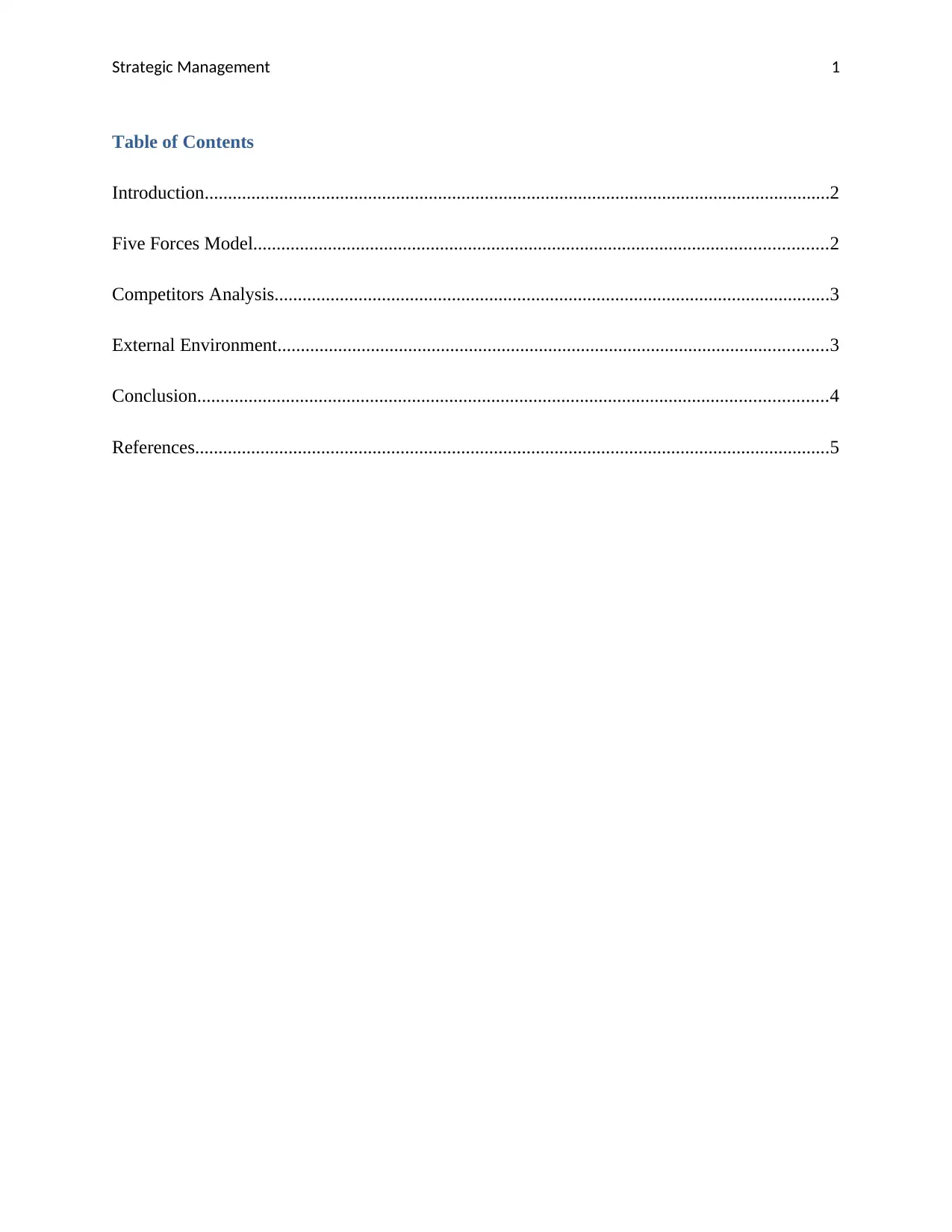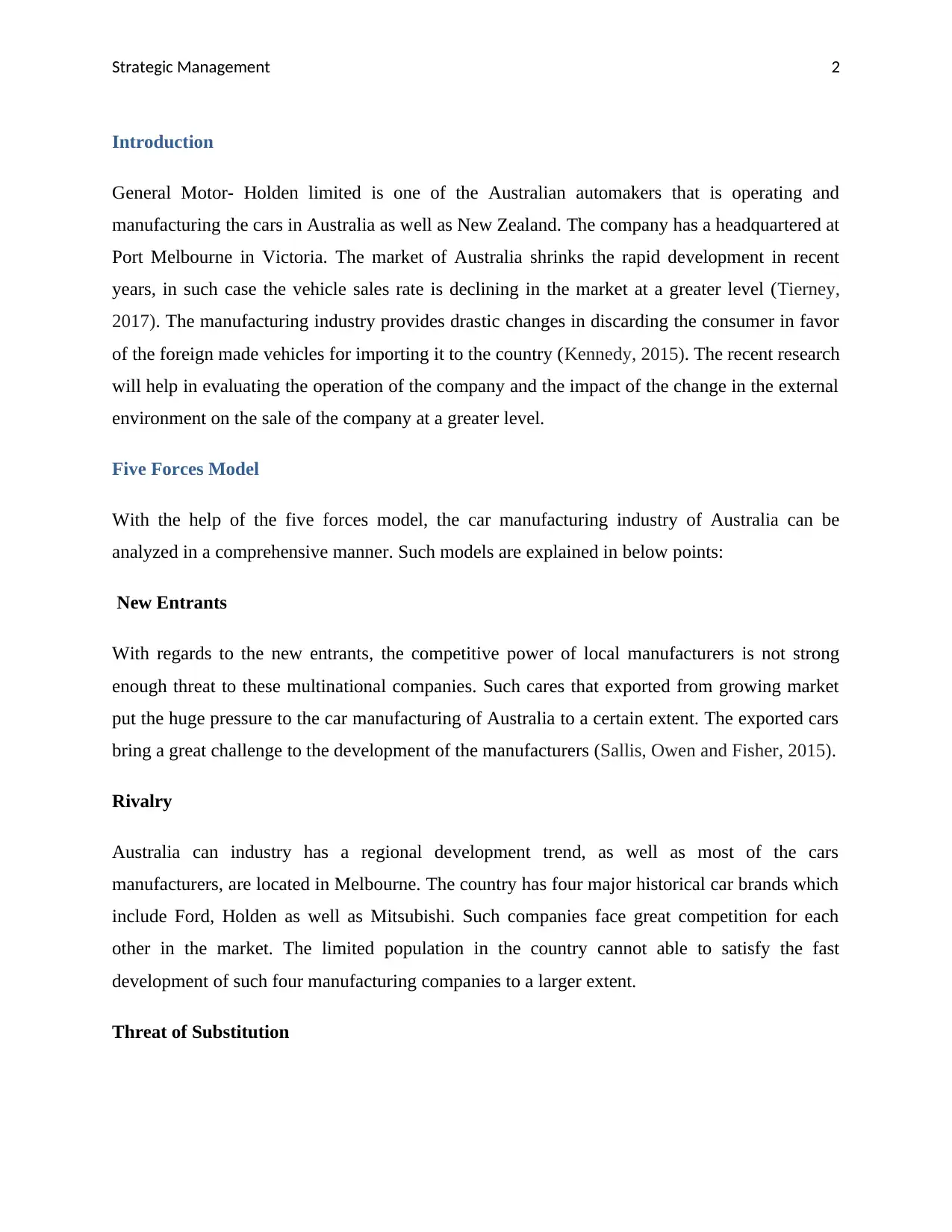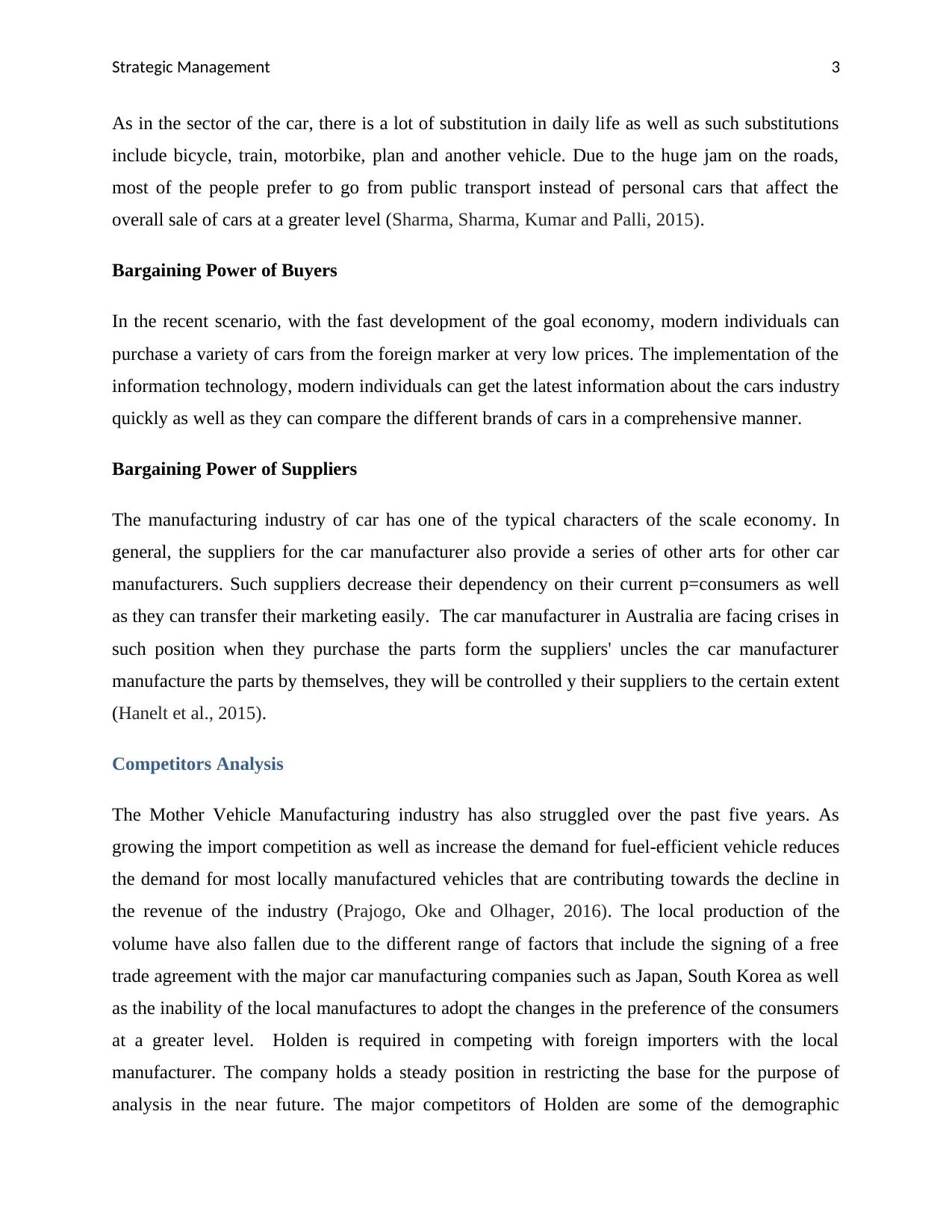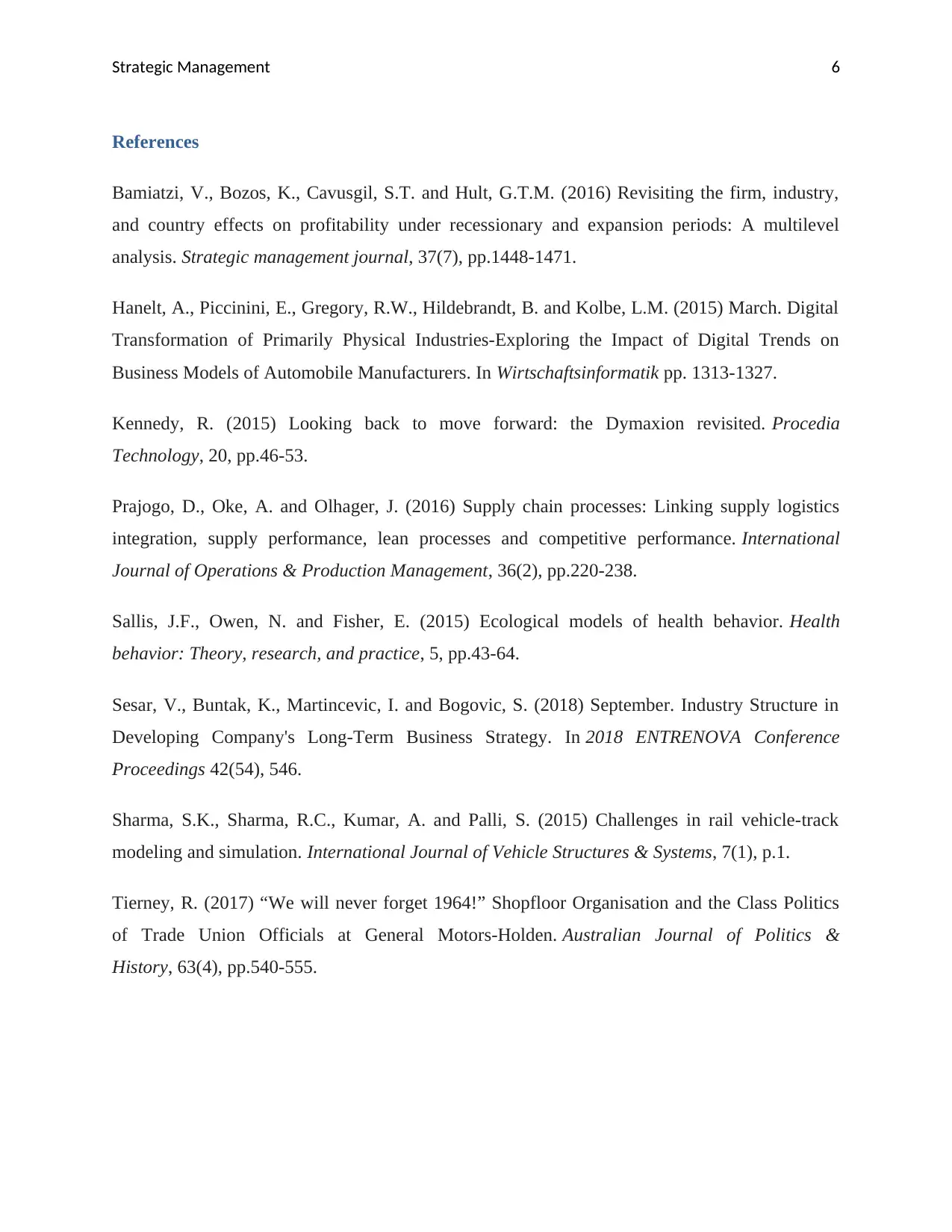Strategic Management Case Study: Holden's Withdrawal from Australia
VerifiedAdded on 2023/04/08
|7
|1404
|357
Case Study
AI Summary
This case study provides a strategic analysis of General Motors-Holden Limited's manufacturing operations in Australia. The analysis begins with an introduction to the company and the context of the shrinking Australian automotive market. It employs the Five Forces model to assess the competitive landscape, examining the threats of new entrants, rivalry among existing competitors, the threat of substitution, and the bargaining power of buyers and suppliers. The study then analyzes Holden's key competitors, including Nissan, Ford, and Toyota, and their impact on the market. Furthermore, the case study delves into the external environment, identifying political, economic, social, and technological factors that influenced Holden's performance and eventual decision to cease manufacturing in Australia. The conclusion summarizes the key findings, emphasizing the combined effects of internal and external pressures on Holden's strategic choices. The assignment adheres to the assessment brief by incorporating at least seven academic journal references, the course textbook, and a word count within the specified parameters.

Running Head: Strategic Management 0
Strategic Management
(Student Name)
3/19/2019
Strategic Management
(Student Name)
3/19/2019
Paraphrase This Document
Need a fresh take? Get an instant paraphrase of this document with our AI Paraphraser

Strategic Management 1
Table of Contents
Introduction......................................................................................................................................2
Five Forces Model...........................................................................................................................2
Competitors Analysis.......................................................................................................................3
External Environment......................................................................................................................3
Conclusion.......................................................................................................................................4
References........................................................................................................................................5
Table of Contents
Introduction......................................................................................................................................2
Five Forces Model...........................................................................................................................2
Competitors Analysis.......................................................................................................................3
External Environment......................................................................................................................3
Conclusion.......................................................................................................................................4
References........................................................................................................................................5

Strategic Management 2
Introduction
General Motor- Holden limited is one of the Australian automakers that is operating and
manufacturing the cars in Australia as well as New Zealand. The company has a headquartered at
Port Melbourne in Victoria. The market of Australia shrinks the rapid development in recent
years, in such case the vehicle sales rate is declining in the market at a greater level (Tierney,
2017). The manufacturing industry provides drastic changes in discarding the consumer in favor
of the foreign made vehicles for importing it to the country (Kennedy, 2015). The recent research
will help in evaluating the operation of the company and the impact of the change in the external
environment on the sale of the company at a greater level.
Five Forces Model
With the help of the five forces model, the car manufacturing industry of Australia can be
analyzed in a comprehensive manner. Such models are explained in below points:
New Entrants
With regards to the new entrants, the competitive power of local manufacturers is not strong
enough threat to these multinational companies. Such cares that exported from growing market
put the huge pressure to the car manufacturing of Australia to a certain extent. The exported cars
bring a great challenge to the development of the manufacturers (Sallis, Owen and Fisher, 2015).
Rivalry
Australia can industry has a regional development trend, as well as most of the cars
manufacturers, are located in Melbourne. The country has four major historical car brands which
include Ford, Holden as well as Mitsubishi. Such companies face great competition for each
other in the market. The limited population in the country cannot able to satisfy the fast
development of such four manufacturing companies to a larger extent.
Threat of Substitution
Introduction
General Motor- Holden limited is one of the Australian automakers that is operating and
manufacturing the cars in Australia as well as New Zealand. The company has a headquartered at
Port Melbourne in Victoria. The market of Australia shrinks the rapid development in recent
years, in such case the vehicle sales rate is declining in the market at a greater level (Tierney,
2017). The manufacturing industry provides drastic changes in discarding the consumer in favor
of the foreign made vehicles for importing it to the country (Kennedy, 2015). The recent research
will help in evaluating the operation of the company and the impact of the change in the external
environment on the sale of the company at a greater level.
Five Forces Model
With the help of the five forces model, the car manufacturing industry of Australia can be
analyzed in a comprehensive manner. Such models are explained in below points:
New Entrants
With regards to the new entrants, the competitive power of local manufacturers is not strong
enough threat to these multinational companies. Such cares that exported from growing market
put the huge pressure to the car manufacturing of Australia to a certain extent. The exported cars
bring a great challenge to the development of the manufacturers (Sallis, Owen and Fisher, 2015).
Rivalry
Australia can industry has a regional development trend, as well as most of the cars
manufacturers, are located in Melbourne. The country has four major historical car brands which
include Ford, Holden as well as Mitsubishi. Such companies face great competition for each
other in the market. The limited population in the country cannot able to satisfy the fast
development of such four manufacturing companies to a larger extent.
Threat of Substitution
⊘ This is a preview!⊘
Do you want full access?
Subscribe today to unlock all pages.

Trusted by 1+ million students worldwide

Strategic Management 3
As in the sector of the car, there is a lot of substitution in daily life as well as such substitutions
include bicycle, train, motorbike, plan and another vehicle. Due to the huge jam on the roads,
most of the people prefer to go from public transport instead of personal cars that affect the
overall sale of cars at a greater level (Sharma, Sharma, Kumar and Palli, 2015).
Bargaining Power of Buyers
In the recent scenario, with the fast development of the goal economy, modern individuals can
purchase a variety of cars from the foreign marker at very low prices. The implementation of the
information technology, modern individuals can get the latest information about the cars industry
quickly as well as they can compare the different brands of cars in a comprehensive manner.
Bargaining Power of Suppliers
The manufacturing industry of car has one of the typical characters of the scale economy. In
general, the suppliers for the car manufacturer also provide a series of other arts for other car
manufacturers. Such suppliers decrease their dependency on their current p=consumers as well
as they can transfer their marketing easily. The car manufacturer in Australia are facing crises in
such position when they purchase the parts form the suppliers' uncles the car manufacturer
manufacture the parts by themselves, they will be controlled y their suppliers to the certain extent
(Hanelt et al., 2015).
Competitors Analysis
The Mother Vehicle Manufacturing industry has also struggled over the past five years. As
growing the import competition as well as increase the demand for fuel-efficient vehicle reduces
the demand for most locally manufactured vehicles that are contributing towards the decline in
the revenue of the industry (Prajogo, Oke and Olhager, 2016). The local production of the
volume have also fallen due to the different range of factors that include the signing of a free
trade agreement with the major car manufacturing companies such as Japan, South Korea as well
as the inability of the local manufactures to adopt the changes in the preference of the consumers
at a greater level. Holden is required in competing with foreign importers with the local
manufacturer. The company holds a steady position in restricting the base for the purpose of
analysis in the near future. The major competitors of Holden are some of the demographic
As in the sector of the car, there is a lot of substitution in daily life as well as such substitutions
include bicycle, train, motorbike, plan and another vehicle. Due to the huge jam on the roads,
most of the people prefer to go from public transport instead of personal cars that affect the
overall sale of cars at a greater level (Sharma, Sharma, Kumar and Palli, 2015).
Bargaining Power of Buyers
In the recent scenario, with the fast development of the goal economy, modern individuals can
purchase a variety of cars from the foreign marker at very low prices. The implementation of the
information technology, modern individuals can get the latest information about the cars industry
quickly as well as they can compare the different brands of cars in a comprehensive manner.
Bargaining Power of Suppliers
The manufacturing industry of car has one of the typical characters of the scale economy. In
general, the suppliers for the car manufacturer also provide a series of other arts for other car
manufacturers. Such suppliers decrease their dependency on their current p=consumers as well
as they can transfer their marketing easily. The car manufacturer in Australia are facing crises in
such position when they purchase the parts form the suppliers' uncles the car manufacturer
manufacture the parts by themselves, they will be controlled y their suppliers to the certain extent
(Hanelt et al., 2015).
Competitors Analysis
The Mother Vehicle Manufacturing industry has also struggled over the past five years. As
growing the import competition as well as increase the demand for fuel-efficient vehicle reduces
the demand for most locally manufactured vehicles that are contributing towards the decline in
the revenue of the industry (Prajogo, Oke and Olhager, 2016). The local production of the
volume have also fallen due to the different range of factors that include the signing of a free
trade agreement with the major car manufacturing companies such as Japan, South Korea as well
as the inability of the local manufactures to adopt the changes in the preference of the consumers
at a greater level. Holden is required in competing with foreign importers with the local
manufacturer. The company holds a steady position in restricting the base for the purpose of
analysis in the near future. The major competitors of Holden are some of the demographic
Paraphrase This Document
Need a fresh take? Get an instant paraphrase of this document with our AI Paraphraser

Strategic Management 4
companies such as Nissan, Ford, and Daimler Chrysler. In the case of foreign companies, it
includes Honda and Toyota Motors. Nissan has set up its brand as an innovative and top
manufacturer in Japan. They have over 1.5 million employee that give great competition to the
company in an effective manner (Bamiatzi, Bozos, Cavusgil and Hult, 2016).
External Environment
The external factors greatly affected the overall performance of the company at a greater level. It
plays a vital role in closing up the company from their country. The environment of the country
has created a negative impact on the company at a greater level. There are certain factors of
environment that affected the overall performance f the company as they are explained in below
points:
Political Factor
Since the year 196, there was buyer strong as well as s strict laws with the high level of
government intervention that has affected the company as well as other car industries at a greater
level. The Abbott government had attracted the company for failing to immediately clarify their
long-term intentions in Australia. With the potential increases the rate of tax, it greatly affected
don the profit margin of the company.
Economical Factor
The external factors of the high growth rate of the developing market create a threat for the
company due to the reason, it welcome international companies to enter in such market that
enhances the cut-throat competition in the competitive market. The survival for the company was
tough due to[ the unnecessary entrance of new companies in the market at a greater level.
Social Factor
Most of the population in Austral is concern towards the ecological products. They prefer to
prerace electric vehicles for their daily uses to preserve fuels. Therefore, it affected the overall
sale of the company at a greater level. The consumers are switching towards other brands and
products that decrease the sale of the company at a greater level.
companies such as Nissan, Ford, and Daimler Chrysler. In the case of foreign companies, it
includes Honda and Toyota Motors. Nissan has set up its brand as an innovative and top
manufacturer in Japan. They have over 1.5 million employee that give great competition to the
company in an effective manner (Bamiatzi, Bozos, Cavusgil and Hult, 2016).
External Environment
The external factors greatly affected the overall performance of the company at a greater level. It
plays a vital role in closing up the company from their country. The environment of the country
has created a negative impact on the company at a greater level. There are certain factors of
environment that affected the overall performance f the company as they are explained in below
points:
Political Factor
Since the year 196, there was buyer strong as well as s strict laws with the high level of
government intervention that has affected the company as well as other car industries at a greater
level. The Abbott government had attracted the company for failing to immediately clarify their
long-term intentions in Australia. With the potential increases the rate of tax, it greatly affected
don the profit margin of the company.
Economical Factor
The external factors of the high growth rate of the developing market create a threat for the
company due to the reason, it welcome international companies to enter in such market that
enhances the cut-throat competition in the competitive market. The survival for the company was
tough due to[ the unnecessary entrance of new companies in the market at a greater level.
Social Factor
Most of the population in Austral is concern towards the ecological products. They prefer to
prerace electric vehicles for their daily uses to preserve fuels. Therefore, it affected the overall
sale of the company at a greater level. The consumers are switching towards other brands and
products that decrease the sale of the company at a greater level.

Strategic Management 5
Technological Factor
It is one of the factors that affect the overall cost of the company at a greater level. The company
implements technologies for its operation and to develop a competitive advantage. however, it
increases the cost to the company at greater level due to the reason their number of sales
decrease at a greater level that affected on the overall cost that has been invested in technology
that causes loss to the company at a greater level.
Conclusion
From the above analysis, it can be concluded that the overall performance of Holden greatly
affected the external environment as well as internal environment. The competition in the
automobile industry of Australia has increased at a greater level due to the free trade policies
signed by the country with foreign companies. They have taken the market of local manufactures
of cars that affected the overall performance of the company at a greater level.
Technological Factor
It is one of the factors that affect the overall cost of the company at a greater level. The company
implements technologies for its operation and to develop a competitive advantage. however, it
increases the cost to the company at greater level due to the reason their number of sales
decrease at a greater level that affected on the overall cost that has been invested in technology
that causes loss to the company at a greater level.
Conclusion
From the above analysis, it can be concluded that the overall performance of Holden greatly
affected the external environment as well as internal environment. The competition in the
automobile industry of Australia has increased at a greater level due to the free trade policies
signed by the country with foreign companies. They have taken the market of local manufactures
of cars that affected the overall performance of the company at a greater level.
⊘ This is a preview!⊘
Do you want full access?
Subscribe today to unlock all pages.

Trusted by 1+ million students worldwide

Strategic Management 6
References
Bamiatzi, V., Bozos, K., Cavusgil, S.T. and Hult, G.T.M. (2016) Revisiting the firm, industry,
and country effects on profitability under recessionary and expansion periods: A multilevel
analysis. Strategic management journal, 37(7), pp.1448-1471.
Hanelt, A., Piccinini, E., Gregory, R.W., Hildebrandt, B. and Kolbe, L.M. (2015) March. Digital
Transformation of Primarily Physical Industries-Exploring the Impact of Digital Trends on
Business Models of Automobile Manufacturers. In Wirtschaftsinformatik pp. 1313-1327.
Kennedy, R. (2015) Looking back to move forward: the Dymaxion revisited. Procedia
Technology, 20, pp.46-53.
Prajogo, D., Oke, A. and Olhager, J. (2016) Supply chain processes: Linking supply logistics
integration, supply performance, lean processes and competitive performance. International
Journal of Operations & Production Management, 36(2), pp.220-238.
Sallis, J.F., Owen, N. and Fisher, E. (2015) Ecological models of health behavior. Health
behavior: Theory, research, and practice, 5, pp.43-64.
Sesar, V., Buntak, K., Martincevic, I. and Bogovic, S. (2018) September. Industry Structure in
Developing Company's Long-Term Business Strategy. In 2018 ENTRENOVA Conference
Proceedings 42(54), 546.
Sharma, S.K., Sharma, R.C., Kumar, A. and Palli, S. (2015) Challenges in rail vehicle-track
modeling and simulation. International Journal of Vehicle Structures & Systems, 7(1), p.1.
Tierney, R. (2017) “We will never forget 1964!” Shopfloor Organisation and the Class Politics
of Trade Union Officials at General Motors‐Holden. Australian Journal of Politics &
History, 63(4), pp.540-555.
References
Bamiatzi, V., Bozos, K., Cavusgil, S.T. and Hult, G.T.M. (2016) Revisiting the firm, industry,
and country effects on profitability under recessionary and expansion periods: A multilevel
analysis. Strategic management journal, 37(7), pp.1448-1471.
Hanelt, A., Piccinini, E., Gregory, R.W., Hildebrandt, B. and Kolbe, L.M. (2015) March. Digital
Transformation of Primarily Physical Industries-Exploring the Impact of Digital Trends on
Business Models of Automobile Manufacturers. In Wirtschaftsinformatik pp. 1313-1327.
Kennedy, R. (2015) Looking back to move forward: the Dymaxion revisited. Procedia
Technology, 20, pp.46-53.
Prajogo, D., Oke, A. and Olhager, J. (2016) Supply chain processes: Linking supply logistics
integration, supply performance, lean processes and competitive performance. International
Journal of Operations & Production Management, 36(2), pp.220-238.
Sallis, J.F., Owen, N. and Fisher, E. (2015) Ecological models of health behavior. Health
behavior: Theory, research, and practice, 5, pp.43-64.
Sesar, V., Buntak, K., Martincevic, I. and Bogovic, S. (2018) September. Industry Structure in
Developing Company's Long-Term Business Strategy. In 2018 ENTRENOVA Conference
Proceedings 42(54), 546.
Sharma, S.K., Sharma, R.C., Kumar, A. and Palli, S. (2015) Challenges in rail vehicle-track
modeling and simulation. International Journal of Vehicle Structures & Systems, 7(1), p.1.
Tierney, R. (2017) “We will never forget 1964!” Shopfloor Organisation and the Class Politics
of Trade Union Officials at General Motors‐Holden. Australian Journal of Politics &
History, 63(4), pp.540-555.
1 out of 7
Related Documents
Your All-in-One AI-Powered Toolkit for Academic Success.
+13062052269
info@desklib.com
Available 24*7 on WhatsApp / Email
![[object Object]](/_next/static/media/star-bottom.7253800d.svg)
Unlock your academic potential
Copyright © 2020–2025 A2Z Services. All Rights Reserved. Developed and managed by ZUCOL.





